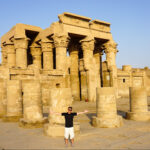Nestled along the lush banks of the majestic Nile River, Luxor stands as a testament to the glorious history and unrivaled splendor of ancient Egypt. With its captivating blend of awe-inspiring temples, intriguing tombs, and vibrant local culture,it beckons travelers on a journey through time. In this article, we embark on an expedition to uncover the captivating wonders that await in this radiant city, exploring its iconic attractions, vibrant markets, and more.
A Glimpse into the Past and Present
You’ll be transported to a bygone era when you set foot in Luxor. With its labyrinthine streets, bustling bazaars, and breathtaking architectural marvels, the city offers a harmonious blend of history and modern life. As the sun casts a golden glow on the monumental structures that dot the landscape, you’ll be left in awe of Luxor’s enduring charm.

Delving into the Majestic Temples
The Luxor Temple: A Gateway to Eternity
Standing proudly on the east bank of the Nile, the Luxor Temple is a majestic ode to ancient Egyptian architecture and spirituality. Adorned with colossal statues, intricate hieroglyphics, and towering columns, this temple was a grand ceremonial center dedicated to the revered gods Amun, Mut, and Khonsu. Step back in time as you wander through its colossal courts and sanctuaries, each whispering tales of an extraordinary civilization.
Karnak Temple Complex: Where Legends Reside
the sprawling Karnak Temple Complex unfolds before you. Karnak is a sprawling ensemble of awe-inspiring structures, a testament to the ancient Egyptians’ architectural prowess and spiritual devotion. The Hypostyle Hall, towering columns, and the sacred lake are just glimpses of the wonders that await within this monumental site.

Embracing the Mystique of the Tombs
Valley of the Kings: Where Pharaohs Rest
Nestled within the barren cliffs on the west bank of the Nile, the Valley of the Kings beckons intrepid explorers. Carved deep into the rock, these tombs were the final resting places of Egypt’s pharaohs and nobles. Descend into the underground chambers and witness the intricate murals that adorn the walls, offering insights into the beliefs and rituals of the ancient Egyptians.
Luxor’s West Bank: A Necropolis of Legends
Beyond the Valley of the Kings, Luxor’s west bank reveals an expansive necropolis where stories of the afterlife come to life. From the impressive mortuary temple of Queen Hatshepsut to the vividly decorated tombs of nobles in the Valley of the Nobles, this region is a tapestry of history waiting to be unraveled.

Enriching Cultural Encounters
Vibrant Souks and Bazaars: Unveiling Local Treasures
Immerse yourself in the vibrant tapestry of Luxor’s local culture by wandering through its bustling souks and bazaars. Engage with friendly vendors as you peruse an array of handcrafted goods, from intricately woven textiles to exquisite pottery. Don’t miss the opportunity to haggle and negotiate – an age-old tradition that adds to the charm of these markets.
Nubian Village: A Glimpse into Indigenous Life
Embark on a journey south of Luxor to experience the rich Nubian heritage. The Nubian Village offers a unique insight into the indigenous way of life, where vibrant colors, lively music, and warm hospitality converge. Engage in traditional dances, savor authentic cuisine, and connect with a community that takes pride in preserving its ancient traditions.

Unveiling Luxor’s Timeless Allure
Hot Air Balloon Rides: Soaring Above the Treasures
For an unparalleled view of Luxor’s sprawling wonders, embark on a mesmerizing hot air balloon ride. As you ascend into the sky, the sun’s first rays paint the landscape in hues of gold, revealing Luxor’s grandeur from a breathtaking vantage point.
Luxor Museum: Showcasing the Finest Artifacts
Delve deeper into the annals of Luxor’s history by visiting the Museum, a treasure trove of archaeological gems. Marvel at meticulously preserved artifacts, including statues, jewelry, and royal mummies, each providing a glimpse into the lives of ancient Egyptians.
FAQs
What is the best time to visit Luxor?
The ideal time to visit Luxor is during the winter months, from November to February, when the weather is pleasant for exploration.
How can I reach Luxor?
it is well-connected by air, with its international airport welcoming flights from major cities worldwide.
Are the ancient sites easily accessible?
Luxor’s attractions are conveniently located, allowing visitors to explore them easily.
Can I hire a guide?
Absolutely! Hiring a local guide enhances your experience by providing insightful commentary and historical context.
Is Luxor safe for travelers?
it is generally safe for tourists, and locals are known for their warmth and hospitality.
Are photography permits required?
Photography permits are needed at specific sites, so be sure to inquire beforehand.
Conclusion
In the heart of Egypt, it stands as an everlasting tribute to a civilization that flourished in the embrace of the Nile. Luxor offers a glimpse into the rich tapestry of ancient and modern life, from awe-inspiring temples to intricate tombs and bustling markets to captivating museums. As you explore the city’s wonders, you’ll find yourself drawn into a narrative that spans millennia, leaving you with a memorable connection to Egypt’s radiant jewel.




